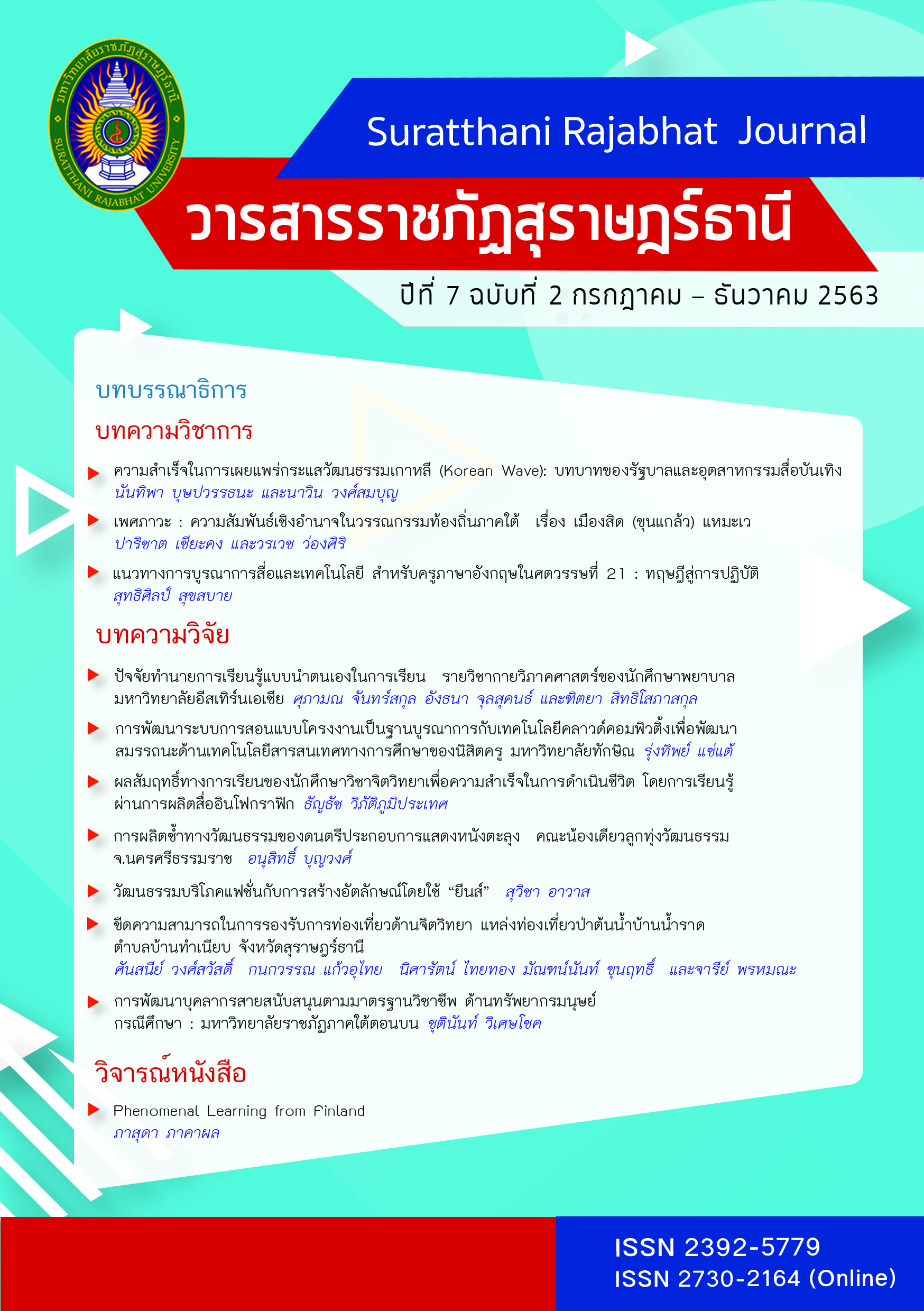The Psychological Carrying Capacity of Tourism in Ban Namrad Water-Source Forest, Bann Tumneab Sub District, Suratthani Province
Main Article Content
Abstract
This paper presents results of the research on tourist behavior of the Ban Namrad Water-source Forest Attraction together with the psychological carrying capacity of Ban Namrad Water-source Forest Attraction, Bann Tumneab sub district, Khiri Rat Nikhom District, Surat Thani Province. A total of 400 questionnaires were used with a sample of tourists. Data were analyzed using descriptive statistics. The statistics used were frequency, percentage and mean. The study’s result of tourists experience and expectations found that most of them never visited Ban Namrad Water-source Forest Attraction. The main activity that tourists do is playing in the water and swimming while most of them aim to learn nature in the forest. A study on the psychological carrying capacity of Ban Namrad Water-source Forest Attraction found that the tourists saw others around 1-20 other people while they engaged in its activities with any number of tourists they want to have in that forest. Too many people is not a problem for their activities. The tourist’s perception level to the number of tourists in Ban Namrad Water-source Forest Attraction has a moderate negative impact on the tourist experience. Average congestion level is moderate. The satisfaction of tourism regulations showed that the tourists had high satisfaction. Regarding the perception on safety, tourists feel highly secure, and the average of tourists perception on its environment is at a high level. When analyzing the factors affecting tourist psychology on a return visit and the satisfaction with the site, it was found that most of them were willing to return to visit Ban Namrad Water-source Forest Attraction again. The average visitor satisfaction was at a high level.
Article Details
References
คณะวนศาสตร์. 2549. การศึกษาขีดความสามารถในการรองรับได้ของพื้นที่อุทยานแห่งชาติเขาใหญ่. คณะวนศาสตร์ มหาวิทยาลัยเกษตรศาสตร์.
จตุรงค์ คงแก้ว ภูวดล บุตรรัตน์ นิพนธ์ พงศ์สุวรรณ และพงศ์ธีระ บัวเพ็ชร. (2556). ขีดความสามารถในการรองรับและมาตรการการจัดการท่องเที่ยวแนวปะการังน้ำตื้นเกาะไข่นอก จังหวัดพังงา. วารสารสิ่งแวดล้อมและทรัพยากรธรรมชาติ, 11(1), 70-87.
ฉลองศรี พิมลสมพงศ์. (2550). การวางแผนและพัฒนาตลาดการท่องเที่ยว. สำนักพิมพ์มหาวิทยาลัยเกษตรศาสตร์.
ดรรชนี เอมพันธุ์. (2546). เอกสารประกอบการสอนวิชาการจัดการวางแผนการท่องเที่ยวเชิงอนุรักษ์ [เอกสารไม่ได้ตีพิมพ์]. ภาควิชาอนุรักษ์วิทยา คณะวนศาสตร์ มหาวิทยาลัยเกษตรศาสตร์.
นภวรรณ ฐานะกาญจน์. (2542). การศึกษาขีดความสามารถในการรองรับการใช้ประโยชน์พื้นที่อุทยานแห่งชาติ [เอกสารไม่ได้ตีพิมพ์]. ภาควิชาอนุรักษ์วิทยาคณะวนศาสตร์, มหาวิทยาลัยเกษตรศาสตร์.
นราวดี บัวขวัญ และคณะ. (2559). ขีดความสามารถในการรองรับของการท่องเที่ยวโดยชุมชนในพื้นที่ 5 จังหวัดชายแดนภาคใต้ (สตูล สงขลา ปัตตานี ยะลา และนราธิวาส. สำนักงานคณะกรรมการวิจัยแห่งชาติ (วช.) และสำนักงานกองทุนสนับสนุนการวิจัย (สกว.).
บรรลือศักดิ์ วงษ์ภักดี. (2552). ขีดความสามารถในการรองรับการใช้ประโยชน์ด้านนันทนาการของอุทยานแห่งชาติเขาชะมวง-เขาวง. Environment and Natural Resources Journal, 7(1), 94 - 109 .
เบญจมาศ ณ ทองแก้ว. (2557). ขีดความสามารถในการรองรับ (Carrying Capacity) การท่องเที่ยวโดยชุมชนของเกาะพิทักษ์ จังหวัดชุมพร ระยะที่ 2. วารสารวิจัยเพื่อการพัฒนาเชิงพื้นที่, 6(4), 79-93.
มยุรี นาสา (2554). ขีดความสามารถด้านจิตวิทยาในการรองรับกิจกรรมท่องเที่ยว บริเวณชายหาดของอุทยานแห่งชาติหมู่เกาะสิมิลัน. ใน การประชุมวิชาการ ม.อ.ภูเก็ตวิจัย ครั้งที่ 4 : สหวิทยาการเพื่อการพัฒนาอย่างยั่งยืน.มหาวิทยาลัยสงขลานครินทร์ วิทยาเขตภูเก็ต.
สุวิมล ติรกานันท์. (2550). การสร้างเครื่องมือวัดตัวแปรในการวิจัยทางสังคมศาสตร์แนวทางสู่การปฏิบัติ. โรงพิมพ์จุฬาลงกรณ์มหาวิทยาลัย.
Anderson, E. W., Fornell, C., & Lehmann, D. R. (1994). Customer satisfaction, marketshare, and profitability:Findings from Sweden. Journal of Marketing, 58(3), 53-66.
Ahmed, I., Shankat, M. Z., Nawaz, M. M., Ahmed, N., & Usman, A. (2011). Determinants of the satisfaction and repurchase intentions of users of short messenger services (SMAS): A study in the telecom sector of pakistan. International Journal of Management, 28(3part1), 763-772.
Bolton, R. N., & Drew, J. H. (1991a). A longitudinal analysis of the impact of service changes on customer attitudes. Journal of Marketin g, 55 , 1-9.
Cronin, J. J., Brady, M. K., & Hult, G. T. M. (2000). Assessing the effects of quality, value, and customer satisfaction on consumer behavioural intentions in service environments. Journal of Retailing, 76(2), 193-218.
Hellier, P. K., Geursen, G. M., Carr, R. A., & Rickard, J. A. (2003). Customer repurchase intention: A general structural equation model. European Journal of Marketing, 37(11/12), 1762 – 1800.
Kotler, P. (1994). Marketing management analysis, planning, implementation, and control (8th ed.). Prentice-Hall.
Oliver, R. L. (1997). Satisfaction: A behavioral perspective on the consumer . McGrawHill.
Shelby, B. and Thomas, A.H. (1986). Carrying Capacity in Recreation Settings. Oregon State University.
Vroom, W. H. (1964). Working and motivation. John Wiley & Sons.
Wagar, J.A. (1964). The Carrying Capacity of Wildlands for Recreation. Forest Science Monographs, 7, 1-23.
Westbrook, R. A. (1980). Intrapersonal affective influences on consumer satisfaction with products. Journal of Consumer Research, 7,
49-54.
Yamane, Taro. (1967). Statistics: An Introductory Analysis, 2nd Edition. Harper and Row.
Zeithmal, V. A., Berry, L. L., & Parasuraman, A. (1996). The behavioral consequences of service quality. Journal of Marketing, 60 (2), 31-46.
บุคลานุกรม
สุจินต์ นาคบำรุง (ผู้ให้สัมภาษณ์). ศันสนีย์ วงศ์สวัสดิ์ และคณะ (ผู้สัมภาษณ์) ที่ ป่าต้นน้ำบ้านน้ำราด ตำบลบ้านทำเนียบ จังหวัดสุราษฎร์ธานี. เมื่อวันที่ 14 พฤษภาคม 2560.


